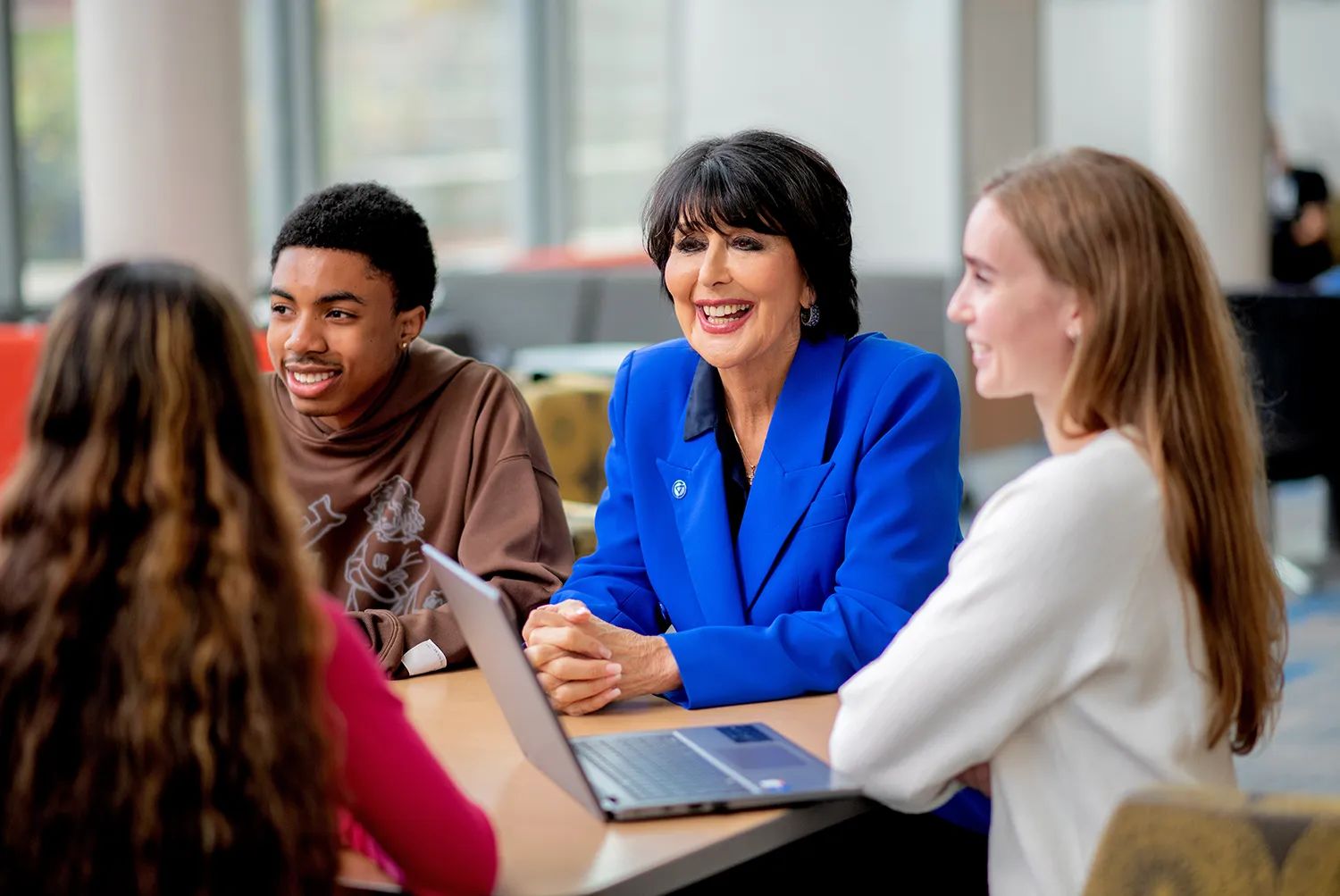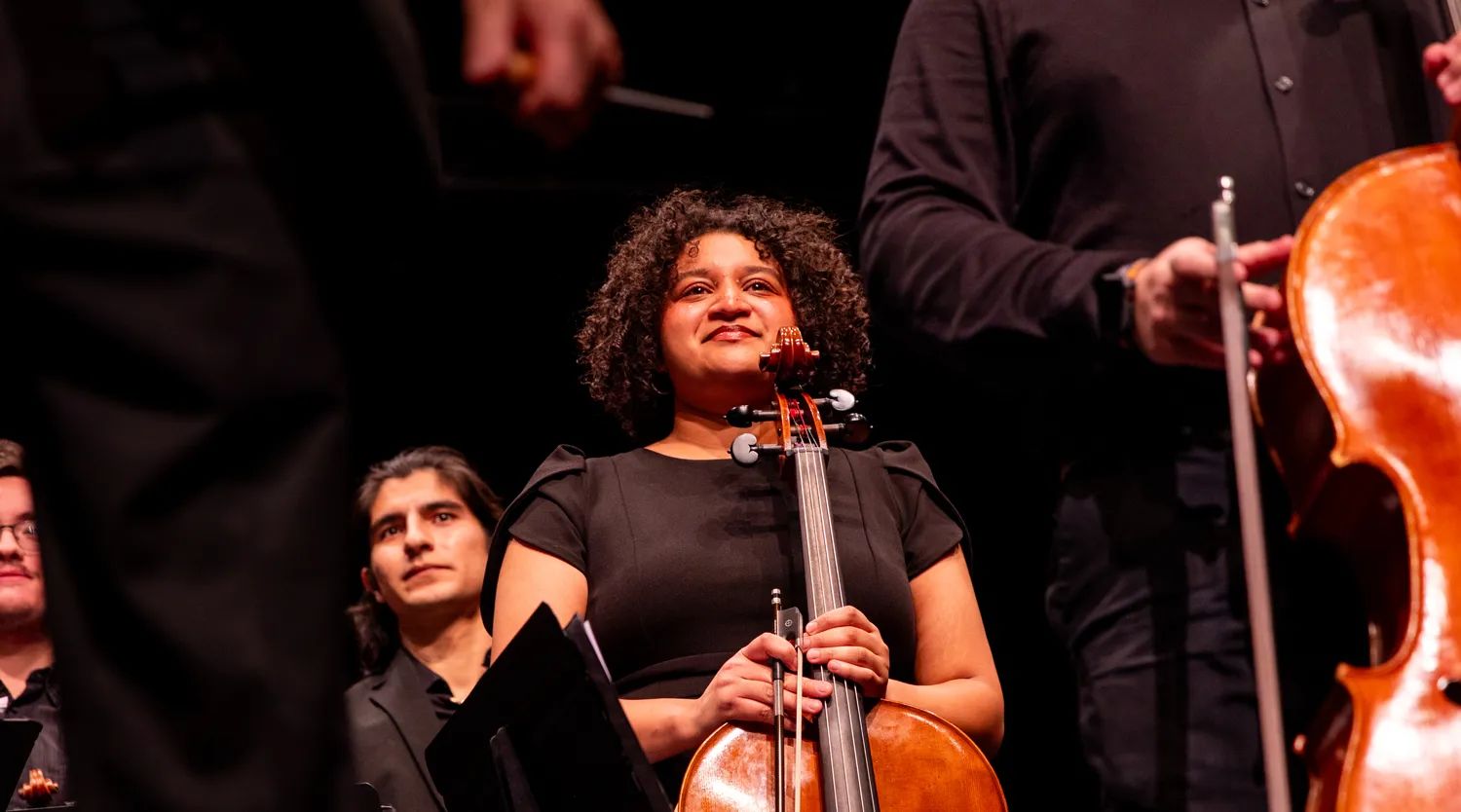PHOTO ESSAY
Office Hours
Students connect with faculty in unique spaces
STORY AND PHOTOS BY KENDRA STANLEY-MILLS
Some faculty offices have a theme, others are cluttered or bare, some are quirky or ordinary. The faculty members, however, share a commonality: When a student walks through their office door, something extraordinary happens. There are lightbulb moments, networking, dialogue, shared benefits and connectedness. From superhero action figures to photos of civil rights and sports leaders to a collection that resembles a curiosity shop, enjoy a glimpse into these faculty offices.

Louis Moore
PROFESSOR OF HISTORY

When Louis Moore was a young man, he had a poster of NBA Hall of Famer Dominique Wilkins on his bedroom wall. Now as a professor of history, including sports history, a nicer copy of that same poster hangs in his office. “My office is an extension of my childhood bedroom,” he said.
Moore has collected a lot of memorabilia in his 16 years at Grand Valley. His office decor reflects what he teaches: U.S. history, civil rights and sports history. Many items are gifts from his students. He said he hopes that anyone who sees his office would feel comfortable to step inside. If the collection of posters, photos and his approachable personality isn't enough, he added a comfy chair to draw students to his office hours. “There’s a space for them.”
Teresa Beck
SENIOR ASSOCIATE DEAN OF THE
COLLEGE OF HEALTH PROFESSIONS

“Offices tell an awful lot about the faculty member,” said Teresa Beck, senior associate dean of the College of Health Professions. “It inspires a conversation that normally wouldn’t happen in a classroom.”
Beck, who has been at Grand Valley since 1995, said she doesn’t remember when she started collecting Coca-Cola memorabilia. Students tell her it’s like a museum.
Beck said she struggled during her first year of college as a first-generation student: “We have so many first-gen students now. They may need more access, have more questions and need more support.”
Beck said in an office setting, students get to know the faculty member outside of the classroom and it’s much more engaging and stimulating. “It just deepens that relationship,” she said. While Beck serves as a college administrator, students still come to her office. And as Beck recalled her struggles as a college student she said, “I wish I had gone to Grand Valley instead of a Big Ten school."
Shannon Biros
PROFESSOR OF CHEMISTRY

Shannon Biros, professor of chemistry, said her office full of plants happened quite by accident.
A friend gave her a fern and it flourished in her east-facing window of Padnos Hall. “It wasn’t on purpose but the plants make me smile,” she said.
Biros hopes the plants will make her students smile, too. She said she encourages students to stop by her office as a way to get to know each other outside of the classroom. “It’s the hardest to get them here the first time,” she said. Once they do, however, it can make all the difference. Depending on individual personalities, students come for 10 minutes or 40 — it doesn’t matter to Biros. “No appointment necessary,” she said. “Just come in.”
Joel Potrykus
ASSISTANT PROFESSOR OF FILM AND VIDEO

Joel Potrykus, assistant professor of film and video, will sometimes hear a quiet knock on his office door. His students know that he practically lives in his office and he encourages their visits. “First off, they’re able to get one-on-one help with their projects, which is not usually possible in the classroom,” he said.
Potrykus’ office is filled with “strange props” people have made for his movies; over the years, it has slowly transformed into a “weird museum.”
“For me, I like an office that recontextualizes or reaffirms the person you see in class. I think a good environment gives a little more depth to the instructor. Sometimes it takes a minute for students first visiting my office to get focused, and that's half the fun.
“I want them to know immediately that I love films, filmmaking and am personally connected to what I'm teaching in class,” Potrykus said.
It also helps Potrykus by giving him bursts of creative energy when he needs it. “I like to glance up and see a lobby card of the two guys from 'An American Werewolf in London' trekking through the moors unaware of the danger ahead," he said. “Sometimes you just need to play a mini Dig Dug arcade for a few minutes.”
Most of all, it’s about the students, “An email only goes so far. But if you really want to fight for a higher grade, then come see me,” he said.
Jason Yancey
PROFESSOR OF MODERN LANGUAGES
AND LITERATURES

During the pandemic, Jason Yancey, professor of modern languages and literatures, said the reasons students came to his office were rarely about class. “They didn’t need the academics piece, they needed the human piece,” he said. “That shifted my thoughts on office hours.” He also noticed in his class of 20 students there are 20 different learning styles. “If they come into my office and I ask what they need it becomes a customized classroom of one,” he said.
Yancey said he wanted his office to look “less like a police station and more like a curiosity shop.”
“I’ve come to realize and appreciate I’m someone who loves things: the quirkiness and silliness of them make me happy,” Yancey said.
His office is filled with masks from Italian theater and colorful puppets he made from travels, action figures and, of course, lots of books. When he put his books on his shelves he realized he had just enough room (perhaps 2 inches) for action figures.
Yancey said he wants his office to be interesting and inspiring to his students, too. “It introduces a touch of silliness into a world that can be scary,” he said. “Academics aside, I’m less interested in whether you can conjugate verbs than I am to find out if you’re OK. Grand Valley is a place that cares about students. That’s why I feel at home here.”
Rebecca Williams
ASSISTANT PROFESSOR OF INTERDISCIPLINARY STUDIES

“You can’t learn if you’re hungry,” said Rebecca Williams, assistant professor of interdisciplinary studies. Her office is full of student gifts, art from around the world, a Ruth Bader Ginsburg doll, a "How to Train a Dragon" stuffed animal made by her niece, student artwork and more. A braided sweetgrass adorns her door, along with notes that indicate it's a safe space.
But the thing most talked about is Williams’ office snack drawer. She brings snacks to feed her students in class, too.
“Some students are food insecure, but the other side is what I’d like to model in the community. Food brings us together. And you know what? I get really good attendance,” she said with a chuckle. “It’s a simple way to engage with students.”
Williams said she fears that the students who need the assistance aren’t coming to her office hours but she encourages students not to be afraid. “When I was in college, my professors would really look out for me. They saved my life at my lowest points.
"I’m not just here academically, I’m not just a face in the classroom. I’m more than just a professor, I’m a resource,” she said.
Kevin Lehnert
PROFESSOR OF MARKETING

Once students get over the initial vulnerability of saying "hi" or that they liked his class, Kevin Lehnert said, “I can do the rest.” Lehnert, professor of marketing, said he realizes that students can find faculty scary, but he always keeps his door open to make it easy for them.
“You don’t have to have a reason [to stop by],” he said.
Students who do find their way to his office find it filled with music. To break the barrier, he has a record collection that he rotates from time to time. His office is cluttered with comic books, tchotchkes and superhero action figures. This is all to create a common connection with students. “I want an office that lets us take our guard down, to be open,” he said. “It disarms.”
Lehnert said he’s there to help students with their questions, but the students also help him to be a better teacher. He said he asks: “How is my class working? Where isn’t it? How can I improve?” His honesty and authenticity endear students to him. “I’m not going to be the next anything, but my students will be,” he said. “It’s my job to help them be their best. By having a welcoming office, I hope students can make the first step and stop on by.”
Katya Grokhovsky
PADNOS DISTINGUISHED
ARTIST-IN-RESIDENCE

Padnos Distinguished Artist-in-Residence Katya Grokhovsky’s studio office overlooks the patio at Calder Art Center. The window allows Grokhovsky, a native of Ukraine and a resident of New York City, to appreciate the seasonal changes, including the varied birds and animals she sees. It also piques the interest for many art students.
When Grokhovsky, who will only be at GVSU through August, sees a student looking at her art she sometimes waves at them and motions to come into her creative space. She said, “You’re welcome to come in. I’m only here for this year, so please take advantage and take a peek.”
Her studio houses a collection of materials she uses in her mixed-media work as well as some work in progress, including a 3D print of a mask from a character she performs called “Bad Woman” and her “thinking wall,” where she displays her thoughts in progress through sketches, collages and text.
Grokhovsky said it’s a gift and an opportunity for dialogue and exchange for students and her, to have exposure to a professional artist, partly because being an artist is being part of a community, in this case, academic. “Art practice exists within a network,” she said. Grokhovsky said she knows entering her studio office is a threshold that can be difficult to cross. “How do you enter someone’s space? I think in my case, the longer I am here, the more familiar and easier it should get,” she said. “Visit me. The space is a connector.”
Eliza MacDonald
SENIOR AFFILIATE FACULTY OF
PHYSICAL THERAPY AND
ATHLETIC TRAINING

“Think of my office hours as a doctor’s office; you can set up an appointment in advance or there is open time when you have a crisis,” said Eliza MacDonald, senior affiliate faculty of physical therapy and athletic training. “My door is always open.”
MacDonald said office hours for her students are about impromptu networking that doesn’t happen in the classroom.
At one point, MacDonald gave extra credit to those who visited. “Once they feel the courage to break the threshold, it breaks the ice. They’re willing to come back," she said.
MacDonald marvels at the view her office provides. When the Physical Therapy and Athletic Training departments moved to the Health Campus, MacDonald was shown her office in CHS, which had a window that looked out to a brick wall, and thought, “At least I have a window.” When construction was complete, MacDonald saw her window view of Dale Chihuly’s "Laker Blue and Opaline Persian Chandelier." “It’s so pretty,” she said. “I’m excited to get to look at it every day.”
See more faculty offices in a photo essay online at gvsu.edu/gvm.
















